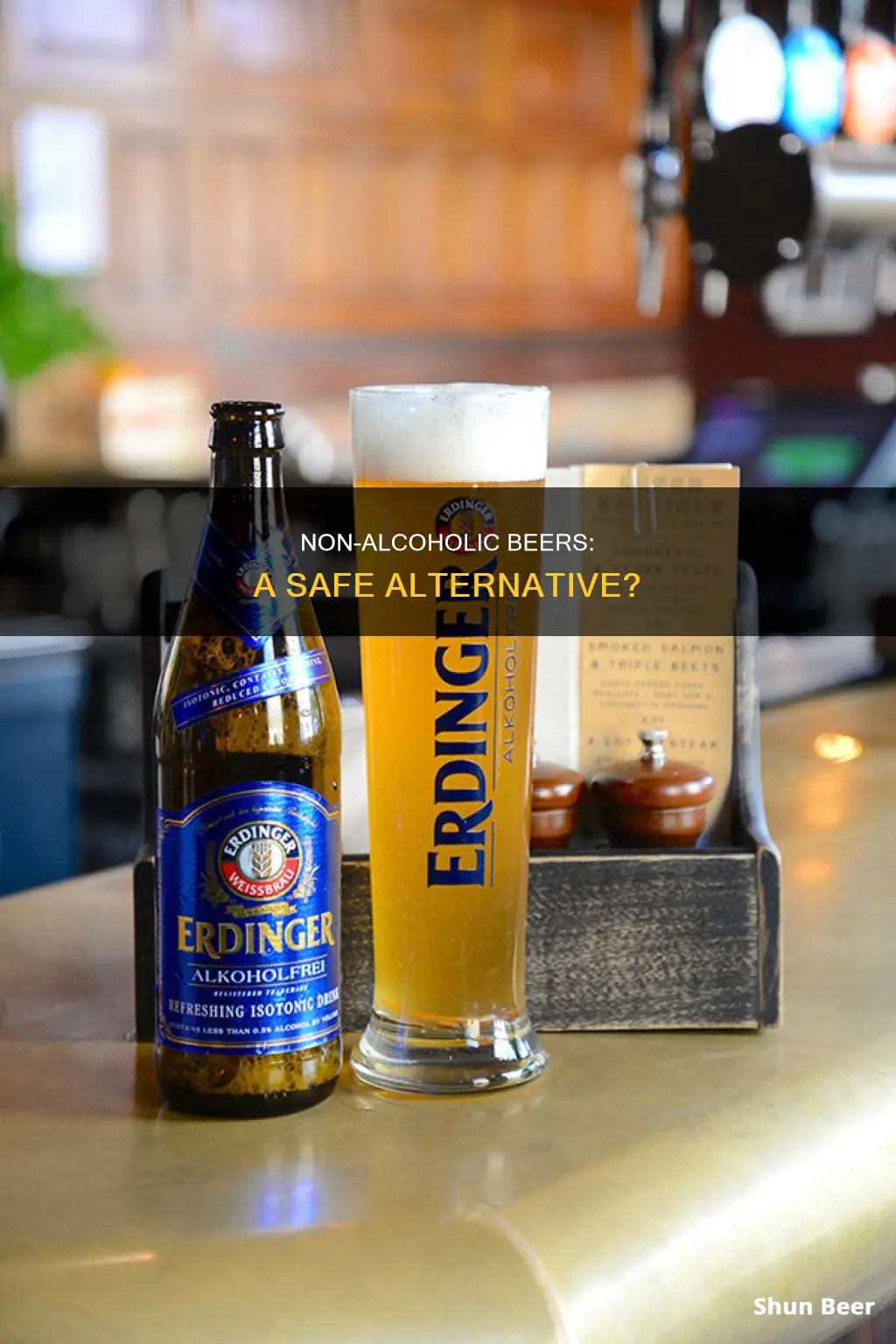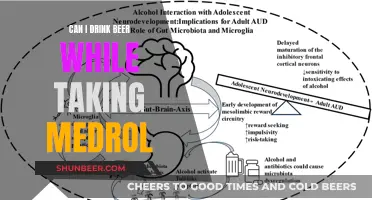
Non-alcoholic beer has become a popular alternative for those looking to cut down on their alcohol consumption or quit drinking altogether. While it may seem like a harmless option, there are some potential risks associated with non-alcoholic beer, especially for individuals with a history of alcohol abuse or addiction. The main concern is that non-alcoholic beer can trigger cravings and emotional associations related to alcohol use, potentially leading to a relapse. Additionally, some non-alcoholic beers may still contain small amounts of alcohol, which can be unsafe for pregnant individuals or those with liver impairments. Ultimately, the decision to consume non-alcoholic beer during recovery depends on individual circumstances, triggers, and personal preferences. It is crucial to consult with healthcare professionals and support groups to determine if non-alcoholic beer aligns with one's recovery journey and sobriety goals.
| Characteristics | Values |
|---|---|
| Alcohol Content | Non-alcoholic beer is defined as beer with 0.5% or less alcohol by volume (ABV). |
| Health Risks | Non-alcoholic beer may still contain trace amounts of alcohol, which could be harmful to people with liver impairments, pregnant people, and those recovering from alcohol use disorder. |
| Social Benefits | Non-alcoholic beer allows people in recovery to feel included in social situations where alcohol is present without compromising their sobriety. |
| Triggers | The smell, taste, and appearance of non-alcoholic beer may trigger cravings and emotional associations for people with a history of alcohol addiction, potentially leading to a relapse. |
| Individual Differences | The impact of non-alcoholic beer varies from person to person. Some individuals in recovery may find it helpful, while others may view it as a risk to their sobriety. |
What You'll Learn

Non-alcoholic beer may still contain alcohol
Non-alcoholic beer is often marketed as a healthy alternative to regular beer and a viable option for those looking to cut down on their alcohol consumption or quit drinking altogether. While non-alcoholic beer typically contains little to no alcohol, it is important to note that it may still contain trace amounts of alcohol.
By definition, non-alcoholic beer refers to beer that has an alcohol content below the legal limit. In most countries, this threshold is set at 0.5% alcohol by volume (ABV) or lower. This means that non-alcoholic beers can legally contain up to 0.5% ABV. While this amount is negligible, it is important to understand that non-alcoholic beers are not completely alcohol-free.
Additionally, it is worth mentioning that the actual alcohol content in non-alcoholic beers may sometimes exceed the labelled amount. Studies have found that some non-alcoholic beers contain higher levels of alcohol than indicated on their labels. This discrepancy can be concerning, especially for individuals who are pregnant or recovering from alcohol use disorders.
The presence of alcohol in non-alcoholic beer poses potential risks for certain individuals. For instance, the small amount of alcohol in non-alcoholic beer can still be unsafe for pregnant individuals, as there is no known safe amount of alcohol consumption during pregnancy. Additionally, the smell and taste of non-alcoholic beer may trigger cravings and increase the risk of relapse for those struggling with alcohol addiction.
In conclusion, while non-alcoholic beer may be a suitable option for some, it is crucial to recognize that it may still contain trace amounts of alcohol. Therefore, individuals who are pregnant, trying to conceive, or recovering from alcohol use disorders should carefully consider the potential risks before consuming non-alcoholic beer.
Steroid Shots and Non-Alcoholic Beer: Safe Mix?
You may want to see also

It can trigger cravings for people with alcohol use disorder
Non-alcoholic beer is often presented as a safe alternative to alcoholic drinks. However, it may not be the best option for people with alcohol use disorder. While non-alcoholic beer typically contains very little alcohol, some small amounts may remain. For example, a non-alcoholic beer may contain approximately one gram of alcohol, while a regular beer contains about 14 grams.
The smell and taste of non-alcoholic beer can be very similar to regular beer, and this can be a trigger for people with alcohol use disorder. Research has shown that the smell of beer alone may be enough to trigger cravings and a subsequent relapse. In one study, scientists found that the smell of alcohol increased levels of dopamine, a brain chemical associated with feelings of elation and pleasure, in rats.
While non-alcoholic beer might be a good option for some, it is important for people with alcohol use disorder to be aware of the potential risks. Consuming non-alcoholic beer may trigger cravings and emotional associations related to past drinking experiences. It is crucial for individuals in recovery to assess their own triggers and consult with healthcare professionals or support groups to determine if non-alcoholic beer is suitable for them.
The decision to consume non-alcoholic beer during recovery is a personal one and should be based on an individual's unique circumstances and triggers. Some people in recovery may find that non-alcoholic beer helps them feel included in social situations without compromising their sobriety. Others may find that the taste and smell of non-alcoholic beer are too triggering and should be avoided.
Beer Salt and Stella Artois: A Perfect Match?
You may want to see also

It can be a valuable tool for people in recovery
Non-alcoholic beer can be a valuable tool for people in recovery from alcohol addiction. It can help them navigate social situations where alcohol is present, allowing them to participate without feeling left out or pressured to consume alcoholic drinks. It provides a sense of normalcy and inclusivity, enabling individuals to enjoy the taste and experience of beer while maintaining their commitment to sobriety.
For those who enjoyed the sensation and experience of drinking alcohol, non-alcoholic beer can be a way to occasionally enjoy a drink while still keeping sobriety an attainable goal. It can help alleviate the feeling of isolation that often comes with recovery, as individuals can join social gatherings and feel included without compromising their sobriety.
Additionally, non-alcoholic beer can be a path to ultimate sobriety for those who find the idea of never drinking again too overwhelming. It creates a space for people to begin restricting their drinking and addressing their addiction, and some may ultimately choose total abstinence.
Non-alcoholic beer also offers health and relaxation benefits. It is typically made from natural ingredients with minimal preservatives or added sugars. It can help individuals unwind and relax without compromising their recovery.
However, it is important to note that non-alcoholic beer may still contain trace amounts of alcohol, and for some in recovery, any amount of alcohol is a risk. Additionally, the taste, smell, and ritual associated with non-alcoholic beer can trigger cravings and lead to a relapse. Thus, individuals in recovery must carefully consider their own triggers and make an informed decision about whether non-alcoholic beer is a suitable choice for their journey.
Viagra and Beer: A Safe Mix?
You may want to see also

It may be a gateway to relapse
Non-alcoholic beer may be a gateway to relapse for people who have quit drinking. While it is marketed as a safe alternative to alcoholic beverages, it is important to be aware of the risks before consuming it.
Non-alcoholic beer often smells and tastes similar to regular beer, and this can be a powerful trigger for people with alcohol use disorder. The smell and taste of beer can evoke strong cravings and lead to a subsequent relapse. Research has shown that the smell of alcohol can increase levels of dopamine, a brain chemical associated with feelings of pleasure and elation. This can be a significant risk factor for relapse, especially if the person is already struggling with cravings or emotional associations related to alcohol.
Additionally, the concept of "near beer" or non-alcoholic alternatives can be psychologically dangerous for people in recovery. The taste and appearance of these beverages are almost identical to regular alcoholic drinks, which can trigger a placebo effect and lead to sensations or emotions similar to those associated with alcohol consumption. This can be confusing and destabilising for people trying to maintain sobriety, as it blurs the lines between alcoholic and non-alcoholic drinks.
Furthermore, non-alcoholic beers may still contain trace amounts of alcohol. By law, non-alcoholic beers can contain up to 0.5% alcohol by volume (ABV). While this amount is negligible and unlikely to cause intoxication, it is still alcohol. For people in recovery, even small amounts of alcohol can be risky and trigger a relapse.
The decision to consume non-alcoholic beer during recovery is a personal one and should be made with caution. It is crucial to assess individual triggers, physical and emotional responses, and consult with healthcare professionals or support groups to determine if non-alcoholic beer is compatible with one's sobriety journey.
Beer and Medication: A Safe Combination?
You may want to see also

It can help people feel included at social events
Non-alcoholic beer can help people feel included at social events. In many cultures, drinking alcohol is a social activity, and abstaining from it can lead to feelings of isolation and exclusion. Non-alcoholic beer provides an option for people to participate in social gatherings without feeling pressured to consume alcoholic drinks. It allows them to blend in and feel included, maintaining their commitment to sobriety while enjoying the taste and experience of beer.
The popularity of non-alcoholic beer has grown in recent years, with people becoming "sober curious" and wanting to reduce their alcohol intake. It provides an alternative for those who want to enjoy the taste and social experience of drinking without the intoxicating effects of alcohol. This can be especially beneficial for those in recovery from alcohol addiction, as it helps them navigate social situations where alcohol is present.
However, it is important to note that non-alcoholic beer may still contain trace amounts of alcohol, and for some recovering alcoholics, it can be a trigger. The decision to consume non-alcoholic beer is a personal one, and individuals must assess their own triggers and consult with professionals to determine if it aligns with their recovery journey.
Light Beers: A Year-Round Refreshing Choice?
You may want to see also







